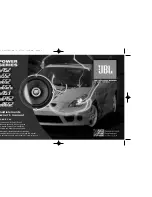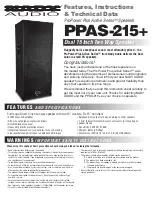
12 Electrostatic Advantages
How can sound be reproduced by something that you are
able to see through? Electrostatic energy makes this possible.
Where the world of traditional loudspeaker technology
deals with cones, domes, diaphragms and ribbons that
are moved with magnetism, the world of electrostatic
loudspeaker deals with charged electrons attracting and
repelling each other.
To fully understand the electrostatic concept, some back-
ground information will be helpful. Remember when you
learned in a science or physics class that like charges repel
each other and opposite charges attract each other? Well,
this principle is the foundation of the electrostatic concept.
An electrostatic transducer consists of three pieces: stators,
the diaphragm and spacers (see figure 9). The diaphragm
is what actually moves to excite the air and create music.
The stator’s job is to remain stationary, hence the word
stator, and to provide a reference point for the moving
diaphragm. The spacers provide the diaphragm with a
fixed distance in which to move between the stators.
As your amplifier sends music signals to an electrostatic
speaker, these signals are changed into two high-voltage
signals that are equal in strength but opposite in polarity.
These high voltage signals are then applied to the stators.
The resulting electrostatic field, created by the opposing
high voltage on the stators, works simultaneously with
and against the diaphragm, consequently moving it back
and forth, producing music. This technique is known as
push-pull operation and is a major contributor to the sonic
purity of the electrostatic concept due to its exceptional
linearity and low distortion.
Since the diaphragm of an electrostatic speaker is uniform-
ly driven over its entire area, it can be extremely light and
flexible. This allows it to be very responsive to transients,
thus perfectly tracing the music signal. As a result, great
delicacy, nuance and clarity is possible. When you look
at the problems of traditional electromagnetic drivers, you
can easily see why this is so beneficial. The cones and
domes which are used in traditional electromagnetic driv-
ers cannot be driven uniformly because of their design.
Cones are driven only at the apex. Domes are driven at
their perimeter. As a result, the rest of the cone or dome
is just “along for the ride”. The very concept of these
drivers requires that the cone or dome be perfectly rigid,
damped and massless. Unfortunately, these conditions are
not available in our world today.
To make these cones and domes move, all electromag-
netic drivers must use voice coils wound on formers, spider
assemblies, and surrounds to keep the cone or dome in
position (see figure 10). These pieces, when combined
with the high mass of the cone or dome materials used,
make it an extremely complex unit with many weaknesses
and potential for failure. These faults contribute to the high
distortion products found in these drivers and is a tremen-
dous disadvantage when you are trying to change motion
as quickly and as accurately as a loudspeaker must
(40,000 times per second!).
e
leCtrostatIC
a
dvantages
Figure 9 .
Cut away view of an electrostatic transducer. Notice the sim-
plicity due to minimal parts usage.
Figure 10 .
Cut away view of a typical moving coil driver. Notice the
complexity due to the high number of parts.










































